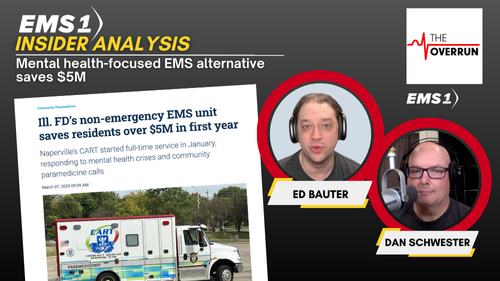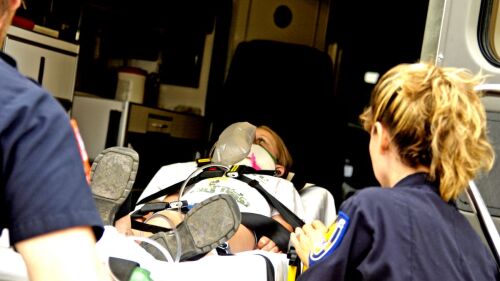BREAKING NEWS
A preliminary report says the pilot surveyed multiple zones, got a ground “all clear,” and made a steep approach when the tail struck a sign about 10 feet up
Funded through Compeer’s Emergency Response Equipment Grants, Schuyler Ambulance will use the award to buy lifting gear and improve on-scene patient handling
The North Shore Rescue Squad EMT, remembered for compassion and dedication, died of rare rhabdomyosarcoma
The city unveiled 10 engines, 13 ambulances and 6 command vehicles to sustain fast response times and replace aging rigs
A Waterbury HR probe says recruits used phones, split screens and Google during an unsupervised final test
EXCLUSIVES
SPECIAL REPORTS
UPCOMING & ON-DEMAND EVENTS
Lessons from agencies mastering real-time collaboration under pressure
End the burnout cycle with proven initiatives to create a more sustainable EMS culture
This informative webinar will provide key information on how two public safety agencies (one police and one fire) funded comprehensive smartphone programs that provided issued devices to all personnel.
Hear from survey investigators as they share data-driven strategies to improve EMS documentation across agencies
Get the insights, expert advice and tools to help your agency score big on grants
How technology can mitigate diversion and ensure compliance
The assessment sequence that could save lives — Are you using it?
Learn how public safety agencies can overcome recruitment roadblocks with real-world strategies rooted in leadership, transparency and cultural change
Learn why outcome-based leadership is crucial for making meaningful changes in your agency and community
Discover why the departments that treat recruiting like marketing are winning — and how to follow their lead
Hear from EMS systems and leaders turning the promise of whole blood into a proven practice for trauma patients
A recent webinar reviewed its value to EMS and shared tips for ensuring accuracy
INDUSTRY INSIGHTS
Discover the benefits of hosting an au pair
How lessons from COVID-19 are shaping the next evolution in PPE for law enforcement, fire, EMS and corrections
These durable, ergonomic mounts help safeguard cardiac monitor investments and streamline the continuum of care
Protecting providers starts with a glove that won’t easily fail
Avon Protection showcases the effectiveness and durability of its latest scalable protective system, designed for eye, nose and mouth protection in real-world conditions
WATCH NOW
In this video, risk management expert Gordon Graham encourages first responders to consider the impact of their time in the fire service
OFF DUTY
The off-duty EMS1 topic highlights off-duty incidents involving EMS personnel, off-duty passions of EMS providers and other industry-relevant information related to off-duty activities.
Bloodwork, CPAP therapy, supplements and nighttime routines can address hidden health issues that sabotage rest — and help medics sleep soundly again
With a few mindful swaps, you can enjoy the flavors of the season without the guilt – or the post-feast food coma
Stock up at 5.11 Tactical, grab a free meal at Chili’s, and enjoy more deals honoring U.S. military and first responders
When Eric Duckwall’s dog bolted during fireworks, it sparked a frantic search — and a new mission
It’s not just about strength or stamina; it’s about grit, mental toughness, and using your body in new ways
On National Punctuation Day, test your knowledge of punctuation
Researchers have identified four common sleep disturbances experienced by public safety personnel
Discover how providers can improve sleep and fight fatigue with simple changes like air filters, blackout curtains and humidity control
True-to-life emergency response finally gets the Hollywood treatment it deserves
PRODUCT RESEARCH CATEGORIES
The Software product category features information, product listings and resources for researching EMS software solutions and covers a variety of software products such as billing, field data and scheduling software, as well as computer-aided dispatch (CAD) and electronic patient care reporting (ePCR).
The EMS Education product category features information and resources for researching EMS education, including tools, products, news articles and more.
Training simulators are key tools for building EMS skills through realistic, scenario-based learning. This topic covers high- and low-fidelity simulators used to practice airway management, trauma care, cardiac response, and other critical interventions. Simulators help EMS personnel improve decision-making, teamwork, and clinical performance in a controlled environment. They also support certification, recertification, and ongoing education. For additional resources used in EMS training, see Training Equipment & Supplies. Explore the articles in this topic to learn how simulators enhance the quality and effectiveness of EMS training programs.
The EMS1 EMS Automated CPR product category is a collection of products and information for researching Automated Cardiopulmonary Resuscitation (CPR) products. It covers a variety of Automated External Defibrillators (AEDs), training tools and other resuscitation products.
The EMS1 Billing Software product category features information and resources for researching Billing Software for your agency, including resources for data management software programs and systems available today.
The Online Training product category features products and information for researching EMS online training and covering a variety of products and services, including training programs/courses available online.
Patient monitoring plays a critical role in prehospital care, enabling EMS providers to track vital signs, assess patient condition, and detect changes in real-time. Monitoring tools include ECG, pulse oximetry, capnography, and blood pressure tracking. These systems support timely decision-making during transport and handoff to hospital teams. Integrated patient monitoring improves documentation accuracy, care continuity, and patient outcomes. Training on device use and data interpretation is essential. EMS Software is another important topic that explores broader tools used in the field. Explore the articles below for guidance on patient monitoring equipment, protocols, and best practices.
Dispatch, call centers, and 911 systems are critical components of emergency response. These operations manage call intake, resource allocation, and communication between dispatchers and field units. Efficient systems and well-trained staff help ensure accurate information, quick response times, and coordinated incident management. Technology like CAD, AVL, and integrated radio systems enhances performance and situational awareness. Dispatch, call centers & 911 services must follow state and national standards for operations and training. Emergency Communications is another important topic focused on tools and infrastructure for responder connectivity. Explore the articles below for insights into staffing, protocols, and system improvements.
The EMS1 Capnography product category features products and information for researching capnography’s use by EMS personnel to aid in their assessment and treatment of patients in the prehospital environment. Click here to download a guide to normal/abnormal capnography waveforms.
Narcotics inventory management is essential for tracking controlled substances used by fire and EMS agencies. Effective systems help ensure accountability, prevent diversion, and maintain compliance with DEA regulations. Digital solutions support secure storage, chain-of-custody documentation, automated logging, and audit readiness. Proper narcotics inventory management also reduces errors and streamlines the restocking process. Agencies should establish clear policies, provide practical training, and maintain thorough oversight.













































